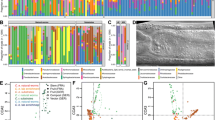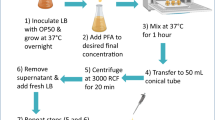Abstract
Laboratory breeding conditions of the model organism C. elegans do not correspond with the conditions in its natural soil habitat. To assess the consequences of the differences in environmental conditions, the effects of air composition, medium and bacterial food on reproductive fitness and/or dietary-choice behavior of C. elegans were investigated. The reproductive fitness of C. elegans was maximal under oxygen deficiency and not influenced by a high fractional share of carbon dioxide. In media approximating natural soil structure, reproductive fitness was much lower than in s tandard laboratory media. I n seminatural media, the reproductive fitness of C. elegans was low with the standard laboratory food bacterium E. coli (γ-Proteobacteria), but significantly higher with C. arvensicola (Bacteroidetes) and B. tropica (β-Proteobacteria) as food. Dietary-choice experiments in semi-natural media revealed a low preference of C. elegans for E. coli but significantly higher preferences for C. arvensicola and B. tropica (among other bacteria). Dietary-choice experiments under quasi-natural conditions, which were feasible by fluorescence in situ hybridization (FISH) of bacteria, showed a high preference of C. elegans for Cytophaga-Flexibacter-Bacteroides, Firmicutes, and β-Proteobacteria, but a low preference for γ-Proteobacteria. The results show that data on C. elegans under standard laboratory conditions have to be carefully interpreted with respect to their biological significance.
Similar content being viewed by others

References
Abada, E.A., Sung, H., Dwivedi, M., Park, B.J., Lee, S.K., and Ahnn, J. (2009). C. elegans behavior of preference choice on bacterial food. Mol. Cells 28, 209–213.
Amann, R.I., Binder, B.J., Olson, R.J., Chisholm, S.W., Devereux, R., and Stahl, D.A. (1990). Combination of 16S rRNA-targeted oligonucleotide probes with flow cytometry for analyzing mixed microbial populations. Appl. Environ. Microbiol. 56, 1919–1925.
Ashelford, K.E., Fry, J.C., Bailey, M.J., and Day, M.J. (2002). Characterization of Serratia isolates from soil, ecological implications and transfer of Serratia proteamaculans subsp. quinovora Grimont et al. 1983 to Serratia quinivorans corrig., sp. nov. Int. J. Syst. Evol. Microbiol. 52, 2281–2289.
American Society for Testing and Materials (ASTM) (2006). Standard guide for conducting soil toxicity tests with the nematode Caenorhabditis elegans. In Annual Book of ASTM Standards 11.06, E2172-01.
Avery, L., and Thomas, J.H. (1997). Feeding and defecation. In C. elegans II, D.L. Riddle, T. Blumenthal, B.J. Meyer, and J.R. Priess, eds. (Cold Spring Harbor, USA: Cold Spring Harbor Laboratory Press), pp. 679–716.
Avery, L., and Shtonda, B.B. (2003). Food transport in the C. elegans pharynx. J. Exp. Biol. 206, 2441–2457.
Bargmann, C.I. (2006). Chemosensation in C. elegans. In Worm Book, The C. elegans Research Community, eds., (http://www.wormbook.org., doi/10.1895/wormbook.1.123.1).
Brenner, S. (1974). The genetics of Caenorhabditis elegans. Genetics 77, 71–94.
Bretscher, A.J., Busch, K.E., and de Bono, M. (2008). A carbon dioxide avoidance behavior is integrated with responses to ambient oxygen and food in Caenorhabditis elegans. Proc. Natl. Acad. Sci. USA 105, 8044–8049.
Burggren, W., and Warburton, S. (2005). Comparative developmental physiology: an interdisciplinary convergence. Annu. Rev. Physiol. 67, 203–223.
Cheung, B.H.H., Cohen, M., Rogers, C., Albayram, O., and de Bono, M. (2005). Experience-dependent modulation of C. elegans behavior by ambient oxygen. Curr. Biol. 15, 905–917.
Daims, H., Brühl, A., Amann, R., Schleifer, K.-H., and Wagner, M. (1999). The domain-specific probe EUB338 is insufficient for the detection of all bacteria: development and evaluation of a more comprehensive probe set. Syst. Appl. Microbiol. 22, 434–444.
Donkin, S.G., and Dusenbery, B.D. (1993). A soil toxicity test using the nematode Caenorhabditis elegans and an effective method of recovery. Arch. Environ. Contam. Toxicol. 25, 145–151.
Fierer, N., Bradford, M.A., and Jackson, R.B. (2007). Towards an ecological classification of soil bacteria. Ecology 88, 1354–1364.
Föll, R.L., Pleyers, A., Lewandovski, G.J., Wermter, C., Hegemann, V., and Paul, R.J. (1999). Anaerobiosis in the nematode Caenorhabditis elegans. Comp. Biochem. Physiol. B 124, 269–280.
Fuchs, B., Wallner, G., Beisker, W., Schwippl, I., Ludwig, W., and Amann, R. (1998). Flow cytometric analysis of the in situ accessibility of Escherichia coli 16S rRNA for fluorescently labeled oligonucleotide probes. Appl. Environ. Microbiol. 64, 4973–4982.
Gobat, J.M., Aragno, M., and Matthey, W. (2003). The Living Soil. (Enfield, USA: Science Publishers).
Gray, J., and Lissmann, H.W. (1964). The locomotion of nematodes. J. Exp. Biol. 41, 135–154.
Gray, J.M., Karow, D.S., Lu, H., Chang, A.J., Chang, J.S., Ellis, R.E., Marletta, M.A., and Bargmann, C.I. (2004). Oxygen sensation and social feeding mediated by a C. elegans guanylate cyclase homologue. Nature 430, 317–322.
Hallem, E.A., and Sternberg, P.W. (2008). Acute carbon dioxide avoidance in Caenorhabditis elegans. Proc. Natl. Acad. Sci. USA 105, 8038–8043.
Hasshoff, M., Boehnisch, C., Tonn, D., Hasert, B., and Schulenburg, H. (2007). The role of Caenorhabditis elegans insulin-like signalling in the behavioural avoidance of pathogenic Bacillus thuringiensis. FASEB J. 21, 1801–1812.
Hope, I.A. (1999). C. elegans. Practical Approach Series. (New York, USA: Oxford University Press).
Kämpfer, P., Young, C.C., Sridhar, K.R., Arun, A.B., Lai, W.A., Shen, F.T., and Rekha, P.D. (2006). Transfer of [Flexibacter] sancti, [Flexibacter] filiformis, [Flexibacter] japonensis and [Cytophaga] arvensicola to the genus Chitinophaga and description of Chitinophaga skermanii sp. nov. Int. J. Syst. Evol. Microbiol. 56, 2223–2228.
Kiontke, K., and Sudhaus, W. (2006). Ecology of Caenorhabditis species. In Worm Book, The C. elegans Research Community, eds., (http://www.wormbook.org., doi/10.1895/wormbook.1.37.1).
Laws, T.R., Atkins, H.S., Atkins, T.P., and Titball, R.W. (2006). The pathogen Pseudomonas aeruginosa negatively affects the attraction response of the nematode Caenorhabditis elegans to bacteria. Microb. Path. 40, 293–297.
Lee, D.L., and Atkinson, H.J. (1976). Physiology of nematodes. (London, UK: Macmillan).
Manz, W., Amann, R., Ludwig, W., Wagner, M., and Schleifer, K.-H. (1992). Phylogenetic oligodeoxynucleotide probes for the major subclasses of Proteobacteria: problems and solutions. Syst. Appl. Microbiol. 15, 593–600.
Meier, H., Amann, R., Ludwig, W., and Schleifer, K.-H. (1999). Specific oligonucleotide probes for in situ detection of a major group of gram-positive bacteria with low DNA G+C content. Syst. Appl. Microbiol. 22, 186–196.
Nakagawa, Y., and Yamasato, K. (1993). Phylogenetic diversity of the genus Cytophaga revealed by 16S rRNA sequencing and menaquinone analysis. J. Gen. Microbiol. 139, 1155–1161.
Neidig, N., Jousset, A., Nunes, F., Bonkowski, M., Paul, R.J., and Scheu, S. (2010). Interference between bacterial feeding nematodes and amoebae relies on innate and inducible mutual toxicity. Funct. Ecol. (in press).
O’sullivan, L.A., Weightman, A.J., and Fry, J.C. (2002). A new degenerate Cytophaga-Flexibacter-Bacteroides-specific 16S ribosomal DNA-targeted oligonucleotide probe reveals high bacterial diversity in River Taff epilithon. Appl. Environ. Microbiol. 68, 201–210.
Oyaizu, H., Komagata, K., Amemura, A., and Harada, T. (1982). A succinoglycan-decomposing bacterium Cytophaga arvensicola sp. nov. J. Gen. Appl. Microbiol. 28, 269–388.
Pankratov, T.A., Kulichevskaya, I.S., Liesack, W., and Dedysh, S.N. (2006). Isolation of aerobic, gliding, xylanolytic and laminarinolytic bacteria from acidic Sphagnum peatlands and emended description of Chitinophaga arvensicola Kämpfer et al. Int. J. Syst. Evol. Microbiol. 56, 2761–2764.
Park, S., Hwang, H., Nam, S.-W., Martinez, F., Austin, R.H., and Ryu, W.S. (2008). Enhanced Caenorhabditis elegans locomotion in a structured microfluidic environment. PLoS ONE 3, e2550.
Reis, V.M., Estrada-de los Santos, P., Tenorio-Salgado, S., Vogel, J., Stoffels, M., Guyon, S., Mavingui, P., Baldani, V.L.D., Schmid, M., Baldani, J.I., et al. (2004). Burkholderia tropica sp. nov., a novel nitrogen-fixing, plant-associated bacterium. Int. J. Syst. Evol. Microbiol. 54, 2155–2162.
Sharabi, K., Hurwitz, A., Simon, A.J., Beitel, G.J., Morimoto, R.I., Rechavi, G., Sznajder, J.I., and Gruenbaum, Y. (2009). Elevated CO2 levels affect development, motility, and fertility and extend life span in Caenorhabditis elegans. Proc. Natl. Acad. Sci. USA 106, 4024–4029.
Shtonda, B.B., and Avery, L. (2006). Dietary choice behavior in Caenorhabditis elegans. J. Exp. Biol. 209, 89–102.
Skvortsova, E.B., and Utkaeva, V.F. (2008). Soil pore space arrangement as a geometric indicator of soil structure. Eurasian Soil Sci. 41, 1354–1361.
Stiernagle, T. (2006). Maintenance of C. elegans. In Worm Book, The C. elegans Research Community, eds., (http://www.wormbook.org., doi/10.1895/wormbook.1.101.1).
Stotzky, G. (1972). Activity, ecology, and population dynamics of microorganisms in soil. CRC Crit. Rev. Microbiol. 2, 59–137.
Sulton, J.E., and Brenner, S. (1974). The DNA of Caenorhabditis elegans. Genetics 77, 95–104.
Van Voorhies, W.A., and Ward, S. (2000). Broad oxygen tolerance in the nematode Caenorhabditis elegans. J. Exp. Biol. 203, 2467–2478
Van Voorhies, W.A., Fuchs, J., and Thomas, S. (2005). The longevity of Caenorhabditis elegans in soil. Biol. Lett. 1, 247–249.
Wullschleger, S., Loewith, R., and Hall, M.N. (2006). TOR signaling in growth and metabolism. Cell 124, 471–484.
Author information
Authors and Affiliations
Corresponding author
Additional information
These authors contributed equally to this work.
About this article
Cite this article
Freyth, K., Janowitz, T., Nunes, F. et al. Reproductive fitness and dietary choice behavior of the genetic model organism Caenorhabditis elegans under semi-natural conditions. Mol Cells 30, 347–353 (2010). https://doi.org/10.1007/s10059-010-0125-9
Received:
Revised:
Accepted:
Published:
Issue Date:
DOI: https://doi.org/10.1007/s10059-010-0125-9



